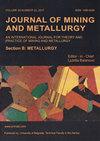应变能对剧烈塑性变形制备的超细晶铜腐蚀行为的影响
IF 1
4区 材料科学
Q3 METALLURGY & METALLURGICAL ENGINEERING
Journal of Mining and Metallurgy Section B-Metallurgy
Pub Date : 2022-01-01
DOI:10.2298/jmmb220101015r
引用次数: 0
摘要
从微观组织演化的角度研究了应变能对强塑性变形(SPD)制备超细晶铜腐蚀行为的影响。SPD处理后的材料经过多次的晶粒细化后呈现出超细晶(UFG)组织,这将影响材料的力学性能和腐蚀性能。均质,可以有效地通过挤压过程或通常被称为简单剪切挤压(SSE),这是SPD技术之一。纯铜在SSE进行了2、4、8和12道工序。采用激光显微镜、透射电镜和x射线衍射观察了SSE处理后样品的结构,通过动电位极化曲线观察了改性Livingstone溶液、1 M NaCl和硫酸溶液的腐蚀行为。SSE处理后的组织表明,SSE处理后的试样在第一次加工时出现了较大的变形,形成了拉长晶和亚晶组织。通过增加SSE孔道数,晶粒形状因过度应变而趋于等轴。与超细晶(UFG)结构相关的x射线展宽在铜样品上处理SSE,导致更小的晶粒尺寸、更高的微应变和更高的位错密度。钝化膜在具有UFG结构外观的材料上形成更加均匀。但在1 M NaCl中,由于铜金属的溶解,电流密度随通道数的增加而降低。UFG结构比粗晶结构具有更多的边界,这些现象说明了Cu溶解能力影响电流密度的原因。晶界表现为阴极区。本文章由计算机程序翻译,如有差异,请以英文原文为准。
Effect of strain energy on corrosion behavior of ultrafine grained copper prepared by severe plastic deformation
Effect of strain energy on corrosion behavior of ultrafine-grained (UFG) copper prepared by severe plastic deformation (SPD) was investigated in term of microstructural evolution. The SPD processed material showed an ultrafine-grained (UFG) structure after grain refinement for several time processes, which will affect mechanical and corrosion behavior. homogeneous, can be obtained efficiently through the pressing process or is commonly known as simple shear extrusion (SSE), which one of the SPD techniques. Pure copper was processed by SSE for two, four, eight and twelve passes. The structure of SSE treated sample was observed by laser microscope and transmission electron microscope as well as X-ray diffraction, The corrosion behavior by potentiodynamic polarization curve was observed modified Livingstone solution, 1 M NaCl and sulphuric solution. The structure of SSE processed showed that the first pass of the SSE processed sample showed large deformation by developing the elongated grain and sub-grain structure. By increasing the SSE pass number, the grain shape became equiaxed due to excessive strain. The X-ray broadening related to ultrafine-grained (UFG) structure processed SSE on the copper sample, leading to smaller crystallite size, higher microstrain, and higher dislocation density. The passive film was developed more homogeneous on the material with UFG structure appearance. However, the current density in 1 M NaCl decreased by an increment of pass number due to the dissolution of copper metal. The UFG structure has more boundaries than coarse grain structure, and these phenomena show why Cu dissolve ability influences the current density. The grain boundary behaves as the cathodic site.
求助全文
通过发布文献求助,成功后即可免费获取论文全文。
去求助
来源期刊
CiteScore
2.00
自引率
40.00%
发文量
19
审稿时长
2 months
期刊介绍:
University of Belgrade, Technical Faculty in Bor, has been publishing the journal called Journal of Mining and Metallurgy since 1965 and in 1997 it was divided in two independent journals dealing with mining and metallurgy separately. Since 2009 Journal of Mining and Metallurgy, Section B: Metallurgy has been accepted in Science Citation Index Expanded.
Journal of Mining and Metallurgy, Section B: Metallurgy presents an international medium for the publication of contributions on original research which reflect the new progresses in theory and practice of metallurgy. The Journal covers the latest research in all aspects of metallurgy including hydrometallurgy, pyrometallurgy, electrometallurgy, transport phenomena, process control, solidification, mechanical working, solid state reactions, materials processing, surface treatment and relationships among processing, structure, and properties of materials.

 求助内容:
求助内容: 应助结果提醒方式:
应助结果提醒方式:


